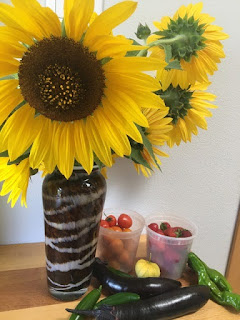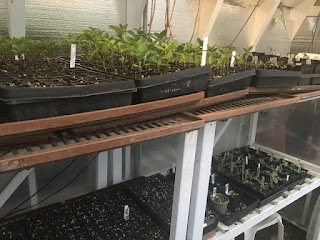We welcome Higher Ground residents as new garden members! Take a stroll here and in our shared organic garden to see how you can help us grow.
Tuesday, October 6, 2020
Friday, September 25, 2020
Beginning the 2020 Higher Ground Garden Season
Tuesday, August 25, 2020
Tuesday, July 7, 2020
Tuesday, June 23, 2020
Master gardener on composting
Our county master gardener who teaches composting emailed me the link and doc below. The composting method at the link is simpler than the method she outlined below. We had a detailed phone conversation and here are my notes.
- Efficient composting requires the right mix of nitrogen (greens), carbon (browns), oxygen and water
- 1 cu. yd. is the minimum compost pile size for holding heat well; there is no maximum size
- Have a collecting bin or garbage can for incoming greens until you have enough
- Start a new pile with 2 parts browns to 1 part greens by volume, mix it all at once
- Add water as you mix the pile, moist by not dripping
- Left undisturbed the pile should reach 120+ deg in 2 days; if not, add more greens
- Left undisturbed the pile should reach 130-160 deg in 3-5 days
- At 7-10 days or 100 deg, turn the pile. Repeat this 3-4 more times or when pile no long reheats.
- Best to turn inside-out since the center is the hottest. Mix in water so only moist, not dripping
- Let the compost age for 4-8 weeks; otherwise, it will draw nitrogen from the soil when applied
- This full cycle is then 2 to 3 months
- If you don't mix browns/greens all at once and don't let the pile sit, then it cools and takes longer
- She's measured 140 deg piles even in winter
- Longer, cooler wait periods are ok but 7-10 days or 100 deg are the most efficient to turn
- Hot composting, as above, is more effort and needs more materials all at once
- Cold composting is much easier but can take a year or more, plus leach nutrients, attract pests
- The two main cold composting examples are leaf piles and straw+manure, both left to sit
- A high peak temperature helps kill volunteer seed
- Different aerobic bacterial take over at different temperatures; bacteria get air during pile turns
- Worms will self manage and seek the cooler parts of the pile
- Is not enough rain in Central Oregon so don't cover piles with tarps; it would also reduce air
- Browns: sawdust is the highest nitrogen. Straw is good along with leaves. Newspapers are ok.
- Suggests no dirt; it adds weight and is a low-quality brown
- Greens: the variety of greens we have is very good; composting is more efficient if chopped smaller, 1" or less
- Suggests bins with screen sides or screened-pallets for better air, not straw bails or solid walls
- One oxygen vent pipe is enough for our current bin; more would cool the core too much
Here is the link to the composting publication.
Here is the handout for you explaining what we talked about on the phone,
Monday, May 18, 2020
Friday, May 15, 2020
Cell trays
This year we're trying cell trays instead of pressing 2" soil blocks for seedlings. We use 72-cell and 128-cell trays; the photo is of J-M. Fortier's use assignments.
So far so go. Trays are easier to fill, move, and keep moist. Extraction has been a bit messy so trying different tools. One soil adjustment planned is a finer perlite. We're learning.
Sunday, April 19, 2020
I miss you guys
Every morning I write a haibun (Japanese form of prose plus haiku). Here is yesterday's:
Spring Gardening
On Saturdays past I helped cook and serve food to hungry gardeners, our community time. We often stretched the hour with stories and laughter.
Today, Corona Virus sits alone at the table.
masks and gloves
no food allowed
measured intimacy
-Janet
Subscribe to:
Comments (Atom)









































